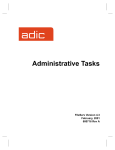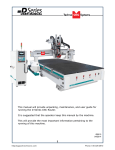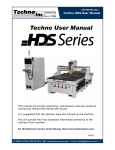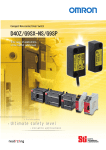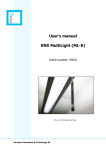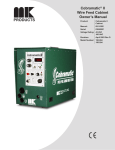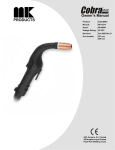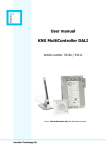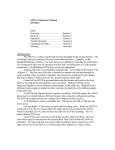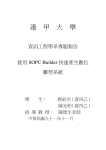Download MK Products ELECTRIC ARC WELDING EQUIPMENT Owner`s manual
Transcript
Product Description Cobra III M.K. Manual Part Number 091-0264 M.K. Form Number NWSA Form Number Effective with Serial Number Voltage Rating OWNERS MANUAL CTIII 550 35000 24 VDC Printing/Revision Date 9/95 This manual applies to the following Torch Model Numbers 160-xxx 161-xxx 162-xxx 163-xxx Cobramatic® Gooseneck Welding Torch MK PRODUCTS, INC. 16882 ARMSTRONG AVE., IRVINE, CALIFORNIA 92714 TEL (714) 863-1234 FAX (714) 474-1428 SAFETY CONSIDERATIONS ELECTRIC ARC WELDING EQUIPMENT CAUTION : READ BEFORE ATTEMPTING INSTALLATION, OPERATION OR MAINTENANCE OF THIS EQUIPMENT 1-1 INTRODUCTION This equipment is intended for ultimate application by commercial/industrial users and for operation by persons trained and experienced in the use and maintenance of welding equipment. Operation should not be undertaken without adequate training in the use of such equipment. Training is available from many public and private schools or similar facilities. Safe practices in the installation, operation and maintenance of this equipment requires proper training in the art, a careful study of the information provided with the equipment, and the use of common sense. Rules for safe use are generally provided by suppliers of welding power sources, compressed gas suppliers, and electrode suppliers. Careful compliance with these rules will promote safe use of this equipment. The following Safety Rules cover some of the more generally found situations. READ THEM CAREFULLY. In case of any doubt, obtain qualified help before proceeding. 1-2 GENERAL PRECAUTIONS A. Burn Prevention ELECTRIC ARC WELDING PRODUCES HIGH INTENSITY HEAT AND ULTRAVIOLET RADIANT ENERGY WHICH MAY CAUSE SERIOUS AND PERMANENT EYE DAMAGE AND WHICH MAY DAMAGE ANY EXPOSED SKIN AREAS. Wear helmet with safety goggles or glasses with side shields underneath, appropriate filter lenses or plates (protected by clear cover glass). This is a must for welding or cutting (and chipping) to protect the eyes from radiant energy and flying metal. Replace cover glass when broken, pitted, or spattered. Medical first aid and eye treatment. First aid facilities and a qualified first aid person should be available for each shift unless medical facilities are close by for immediate treatment of flash burns of the eyes and skin burns. Wear protective clothing - leather (or asbestos) gauntlet gloves, hat, and high safety-toe shoes. Button shirt collar and pocket flaps, and wear cuffless trousers to avoid entry of sparks and slag. Avoid oily or greasy clothing. A spark may ignite them. Flammable hair preparations should not be used by persons intending to weld or cut. Hot metal such as electrode stubs and work pieces should never be handled without gloves. Ear plugs should be worn when working on overhead or in a confined space. A hard hat should be worn when others work overhead. B. Toxic Fume Prevention Adequate ventilation. Severe discomfort, illness or death can result from fumes, vapors, heat, or oxygen enrichment or depletion that welding (or cutting) may produce. Prevent them with adequate ventilation. NEVER ventilate with oxygen. Lead-, cadmium-, zinc-, mercury-, beryllium-bearing and Cobra Gooseneck Owner's Manual - 8/96 similar materials, when welded or cut, may produce harmful concentrations of toxic fumes. Adequate local exhaust ventilation must be used, or each person in the area, as well as the operator, must wear an air-supplied respirator. For beryllium, both must be used. Metals coated with or containing materials that emit toxic fumes should not be heated unless coating is removed form the work surface, the area is well ventilated, or the operator wears an air-supplied respirator. Work in a confined space only while it is being ventilated and, if necessary, while wearing an air-supplied respirator. Gas leaks in a confined space should be avoided. Leaked gas in large quantities can change oxygen concentration dangerously. Do not bring gas cylinders into a confined space. Leaving confined space, shut OFF gas supply at source to prevent possible accumulation of gases in the space if downstream valves have been accidently opened or left open. Check to be sure that the space is safe before reentering it. Vapors from chlorinated solvents can be decomposed by the heat of the arc (or flame) to form PHOSGENE, a highly toxic gas, and other lung and eye irritating products. The ultraviolet (radiant) energy of the arc can also decompose trichloroethylene and perchloroethylene vapors to form phosgene. DO NOT WELD or cut where solvent vapors can be drawn into the welding or cutting atmosphere or where the radiant energy can penetrate to atmospheres containing even minute amounts of trichloroethylene or perchloroethylene. C. Fire and Explosion Prevention Causes of fire and explosion are: combustibles reached by the arc, flame, flying sparks, hot slag, or heated material, misuse of compressed gases and cylinders, and short circuits. BE AWARE THAT flying sparks or falling slag can pass through cracks, along pipes, through windows or doors, and through wall or floor openings, out of sight of the goggled operator. Sparks can fly many feet. To prevent fires and explosion: Keep equipment clean and operable, free of oil, grease, and (in electrical parts) of metallic particles that can cause short circuits. If combustibles are in area, do NOT weld or cut. Move the work if practicable, to an area free of combustibles. Avoid paint spray rooms, dip tanks, storage areas, ventilators. If the work cannot be moved, move combustibles at least 35 feet away, out of reach of sparks and heat; or protect against ignition with suitable and snug-fitting, fire-resistant covers or shields. Walls touching combustibles on opposite sides should not be welded on (or cut). Walls, ceilings, and floor near work should be protected by heat-resistant covers or shields. Fire watcher must be standing by with suitable fire extinguishing equipment during and for some time after welding or cutting if: 1. Appreciable combustibles (including building construction) are within 35 feet. 4. Combustibles adjacent to walls, ceilings, roofs, or metal partitions can be ignited by radiant or conducted heat. Hot work permit should be obtained before operation to ensure supervisor’s approval that adequate precautions have been taken. After work is done, check that area is free of sparks, glowing embers, and flames. An empty container that held combustibles, or that can produce flammable or toxic vapors when heated, must never be welded on or cut, unless container has first been cleaned in accordance with industry standards. This includes: a thorough steam or caustic cleaning (or a solvent of water washing, depending on the combustible’s solubility), followed by purging and inerting with nitrogen or carbon dioxide, and using protective equipment. Water-filling just below working level may substitute for inerting. A container with unknown contents should be cleaned (see paragraph above). Do NOT depend on sense of smell or sight to determine if it is safe to weld or cut. Hollow castings or containers must be vented before welding or cutting. They can explode. Explosive atmospheres. NEVER weld or cut where the air may contain flammable dust, gas, or liquid vapors (such as gasoline). D. Compressed Gas Equipment The safe handling of compressed gas equipment is detailed in numerous industry publications. The following general rules cover many of the most common situations. 1. Pressure Regulators Regulator relief valve is designed to protect only the regulator from overpressure; it is not intended to protect any downstream equipment. Provide such protection with one or more relief devices. Never connect a regulator to a cylinder containing gas other than that for which the regulator was designed. Remove faulty regulator from service immediately for repair (first close cylinder valve). The following symptoms indicate a faulty regulator: Leaks - if gas leaks externally. Excessive Creep - if delivery pressure continues to rise with downstream valve closed. Faulty Gauge - if gauge pointer does not move off stop pin when pressurized, nor returns to stop pin after pressure release. Repair. Do NOT attempt repair. Send faulty regulators for repair to manufacturer’s designated repair center, where special techniques and tools are used by trained personnel. 2. Cylinders 2. Appreciable combustibles are further than 35 feet, but can be ignited by sparks. 3. Openings (concealed or visible) in floors or walls within 35 feet may expose combustibles to sparks. Cylinders must be handled carefully to prevent leaks and damage to their walls, valves, or safety devices: Avoid electrical circuit contact with cylinders including third rails, electrical wires, or welding circuits. They can produced short circuit arcs that may lead to a serious accident. (See 1-3C) ICC or DOT marking must be on each cylinder. It is an assurance of safety when the cylinder is properly handled. Identifying gas content. Use only cylinders with name of gas marked on them; do not rely on color to identify gas content. Notify supplier if unmarked. NEVER DEFACE or alter name, number, or other markings on a cylinder. It is illegal and hazardous. Empties: Keep valves closed, replace caps securely; mark MT; keep them separate from FULLS, and return promptly. Prohibited use. Never use a cylinder or its contents for other than its intended use, NEVER as a support or roller. Locate or secure cylinders so they cannot be knocked over. Passageways and work areas. Keep cylinders clear of areas where they may be stuck. Transporting cylinders. With a crane, use a secure support such as a platform or cradle. Do NOT lift cylinders off the ground by their valves or caps, or by chains, slings, or magnets. Do NOT expose cylinders to excessive heat, sparks, slag, and flame, etc. that may cause rupture. Do not allow contents to exceed 55 degrees C (130 degrees F.) Cool with water spray where such exposure exists. Protect cylinders, particularly valves from bumps, falls, falling objects, and weather. Replace caps securely when moving cylinders. Stuck valve. Do NOT use a hammer or wrench to open a cylinder valve that cannot be opened by hand. Notify your supplier. Mixing gases. NEVER try to mix any gases in a cylinder. that the regulator label and cylinder marking agree, and that the regulator inlet and cylinder outlet match. NEVER Connect a regulator designed for a particular gas or gases to a cylinder containing any other gas. shoes. As necessary, use additional protective clothing such as leather jacket or sleeves, flameproof apron, and fire-resistant leggings. Avoid outer garments of untreated cotton. Tighten connections. When assembling threaded connections, clean and smooth seats where necessary. Tighten. If connection leaks, disassemble, clean, and retighten, using properly fitting wrench. Bare skin protection. Wear dark, substantial clothing. Button collar to protect chest and neck, and button pockets to prevent entry of sparks. Adapters. Use a CGA adapter (available from your supplier) between cylinder and regulator, if one is required. Use two wrenches to tighten adapter marked RIGHT and LEFT HAND threads. 2. Eye and Head Protection Regulator outlet (or hose) connections may be identified by right hand threads for oxygen and left hand threads (with grooved hex on nut or shank) for fuel gas. 5. Pressurizing Steps: Cylinder fittings should never be modified or exchanged. Welding helmet or shield containing a filter plate shade no. 12 or denser must be used when welding. Place over face before striking arc. Protect filter plate with a clear cover plate. Drain regulator of residual gas through suitable vent before opening cylinder (or manifold valve) by turning adjusting screw in (clockwise). Draining prevents excessive compression heat at high pressure seat by allowing seat to open on pressurization. Leave adjusting screw engaged slightly on single-stage regulators. Stand to side of regulator while opening cylinder valve. Open cylinder valve slowly so that regulator pressure increases slowly. When gauge is pressurized (gauge reaches regulator maximum) leave cylinder valve in following position: for oxygen and inert gases, open fully to seal stem against possible leak; for fuel gas, open to less than one turn to permit quick emergency shut-off. Use pressure charts (available from your supplier) for safe and efficient recommended pressure settings on regulators. Check for leaks on first pressurization and regularly thereafter. Brush with soap solution. Bubbles indicate leaks. Clean off soapy water after test; dried soap is combustible. E. User Responsibilities NEVER refill any cylinder. Protect eyes from exposure to arc. Eyes may be damaged by radiant energy when exposed to the electric arc, even when not looking in the direction of the arc. Never look at an electric arc without protection. Cracked or broken helmet or shield should NOT be worn; radiation can be passed through to cause burns. Cracked, broken, or loose filter plates must be replaced IMMEDIATELY. Replace clear cover plate when broken, pitted, or spattered. Flash goggles with side shields MUST be worn under the helmet to give some protection to the eyes should the helmet not be lowered over the face before an arc is struck. Looking at an arc momentarily with unprotected eyes (particularly a high intensity gas-shielded arc) can cause a retinal burn that may leave a permanent dark area in the field of vision. 3. Protection of Nearby Personnel Enclose the welding area. For production welding, a separate room or enclosed bay is best. In open areas, surround the operation with low-reflective, noncombustible screens or panels. Allow for free air circulation, particularly at floor level. Viewing the weld. Provide face shields for all persons who will be looking directly at the weld. Follow all Safety Rules. Remove leaky or defective equipment from service immediately for repair. Read and follow user manual instructions. Others working in area. See that all persons are wearing flash goggles. Prohibited use. Never use hose other than that designed for the specified gas. A general hose identification rule is: red for fuel gas, green for oxygen, and black for inert gases. F. Leaving Equipment Unattended Before starting to weld, make sure that screen flaps or bay doors are closed. Use ferrules or clamps designed for the hose (not ordinary wire or other substitute) as a binding to connect hoses to fittings. G. Rope Staging-Support 3. Hose No copper tubing splices. fittings to splice hose. Use only standard brass Avoid long runs to prevent kinks and abuse. Suspend hose off ground to keep it from being run over, stepped on, or otherwise damaged. Coil excess hose to prevent kinks and tangles. Protect hose from damage by sharp edges, and by sparks, slag, and open flame. Examine hose regularly for leaks, wear, and loose connections. Immerse pressured hose in water; bubbles indicate leaks Repair leaky or worn hose by cutting area out and splicing. Do NOT use tape. 4. Proper Connections Clean cylinder valve outlet of impurities that may clog orifices and damage seats before connecting regulator. Except for hydrogen, crack valve momentarily, pointing outlet away from people and sources of ignition. Wipe with a clean, lintless cloth. Match regulator to cylinder. Before connecting, check Cobra Gooseneck Owner's Manual - 8/96 Close gas supply at source and drain gas. Rope staging-support should not be used for welding or cutting operation; rope may burn. 1-3 ARC WELDING Comply with precautions in 1-1, 1-2, and this section. Arc Welding, properly done, is a safe process, but a careless operator invites trouble. The equipment carries high currents at significant voltages. The arc is very bright and hot. Sparks fly, fumes rise, ultraviolet and infrared energy radiates, weldments are hot, and compressed gases may be used. The wise operator avoids unnecessary risks and protects himself and others from accidents. A. Burn Protection B. Toxic Fume Prevention Comply with precautions in 1-2B. Generator engine exhaust must be vented to the outside air. Carbon monoxide can kill. C. Fire and Explosion Prevention Comply with precautions in 1-2C. Equipment’s rated capacity. Do not overload arc welding equipment. It may overheat cables and cause a fire. Loose cable connections may overheat or flash and cause afire. Never strike an arc on a cylinder or other pressure vessel. It creates a brittle area that can cause a violent rupture or lead to such a rupture later under rough handling. Comply with precautions in 1-2. The welding arc is intense and visibly bright. Its radiation can damage eyes, penetrate lightweight clothing, reflect from lightcolored surfaces, and burn the skin and eyes. Skin burns resemble acute sunburn; those from gas-shielded arcs are more severe and painful. DON’T GET BURNED; COMPLY WITH PRECAUTIONS. 1. Protective Clothing Wear long-sleeve clothing in addition to gloves, hat, and D. Compressed Gas Equipment Comply with precautions in 1-2D. E. Shock Prevention Exposed electrically hot conductors or other bare metal in the welding circuit, or in ungrounded, electrically-HOT equipment can fatally shock a person whose body becomes a conductor. DO NOT STAND, SIT, LIE, LEAN ON, OR TOUCH a wet surface when welding without suitable protection. shut OFF all power, and remove line fuses (or lock or red-tag switches) to prevent accidental turning ON of power. Disconnect all cables from welding power source, and pull all 115 volts linecord plugs. To protect against shock: Do not open power circuit or change polarity while welding. If, in an emergency, it must be disconnected, guard against shock burns or flash from switch arcing. Leaving equipment unattended. Always shut OFF, and disconnect all power to equipment. Keep body and clothing dry. Never work in damp area without adequate insulation against electrical shock. Stay on a dry duckboard, or rubber mat when dampness or sweat cannot be avoided. Sweat, sea water, or moisture between body and an electrically HOT part - or grounded metal - reduces the body surface electrical resistance, enabling dangerous and possibly lethal currents to flow through the body. 1. Grounding the Equipment When installing, connect the frames of each unit such as welding power source, control, work table, and water circulator to the building ground. Conductors must be adequate to carry ground currents safely. Equipment made electrically HOT by stray currents may shock, possibly fatally. Do NOT GROUND to electrical conduit, or to a pipe carrying ANY gas or a flammable liquid such as oil or fuel. Three-phase connection. Check phase requirement of equipment before installing. If only three-phase power is available, connect single-phase equipment to only two wires of the three-phase line. Do NOT connect the equipment ground lead to the third (live) wire, or the equipment will become electrically HOT - a dangerous condition that can shock, possibly fatally. Before welding, check ground for continuity. Be sure conductors are touching bare metal of equipment frames at connections. If a line cord with a ground lead is provided with the equipment for connection to a switch box, connect the ground lead to the grounded switch box. If a three-prong plug is added for connection to a grounded mating receptacle, the ground lead must be connected to the ground prong only. If the line cord comes with a threeprong plug, connect to a grounded mating receptacle. Never remove the ground prong from a plug, or use a plug with a broken ground prong. 2. Connectors Fully insulated lock-type connectors should be used to join welding cable lengths. 3. Cables Frequently inspect cables for wear, cracks, and damage. IMMEDIATELY REPLACE those with excessively worn or damaged insulation to avoid possibly lethal shock from bared cable. Cables with damaged areas may be taped to give resistance equivalent to original cable. Keep cable dry, free of oil and grease, and protected from hot metal and sparks. 4. Terminals and Other Exposed Parts Terminals and other exposed parts of electrical units should have insulating covers secured before operation. 5. Electrode Wire Electrode wire becomes electrically HOT when the power switch of gas metal-arc welding equipment is ON and welding gun trigger is pressed. Keep hands and body clear of wire and other HOT parts. 6. Safety Devices Safety devices such as interlocks and circuit breakers should not be disconnected or shunted out. Before installation, inspection, or service of equipment, Cobra Gooseneck Owner's Manual - 8/96 Power disconnect switch must be available near the welding power source. INTRODUCTION Congratulations! You have just purchased the latest generation of the popular Cobra System III Gooseneck Torch. With the quest to be a Leader in Welding Technology this generation of Cobra System III Gooseneck Torch is the best MK Products has ever developed. Stronger gas and water tubes, motor and gearbox with enough torque and speed to feed aluminum and flux core wires from .030 to 1/16, solid and hard wires from .030 to .045. Matched up with any of MK’s Cobramatic wire feed system is a combination that can not be beat. This manual details the installation and operation of your Cobra System III Gooseneck Torch. Properly installed, adjusted for your welding conditions, it will be a reliable welding system producing consistently uniform welds. Conduits for all MK torches (System III Gooseneck, Prince, and King) are interchangeable. Some parts are interchangeable with existing Gooseneck and Prince torches (contact tips, gas cups, drive and idler rolls). Consult your owner’s manual for more information on your Cobra System III Gooseneck torch. Cobra Gooseneck Owner's Manual - 8/96 Page 26 SPECIFICATIONS WIRE CAPACITY .030-.045 solid and hard wire .030-1/16 aluminum and cored wire WIRE SPEED 800 IPM Max. at 120VAC Feeder Input DUTY CYCLE Air Cooled Torches (161 and 163 series) - 200 amps @ 50% Water Cooled Torches (160 and 162 series) - 250 amps @ 50% Water Cooled Torches w/ Optional Heavy Duty Finned Gas Cup - 300 amps @ 50% All are at 25 volts max. using Argon Gas SHIPPING WEIGHT Air Cooled 15' ......................... 25' ......................... 50' ......................... Water Cooled 15' ......................... 25' ......................... 50' ......................... 13 lbs. 18 lbs. 30 lbs. 15 lbs. 19 lbs. 32 lbs. SUPPORT EQUIPMENT REQUIRED C.V. or C.C. Power Source of sufficient capacity for your needs. Regulated gas supply and hoses. Properly sized power leads from power source to wire feeder and ground. Water source and hose capable of providing a minimum of 1 qt/min. at 45 p.s.i. when using water cooled torches. COOLANT RECOMMENDATIONS 1. Use a name-brand additive which does not contain reactive sulphur or chlorine and does not react with copper, brass, or aluminum. 2. Check coolant periodically to remain within limits of the following: A. B. C. D. Cobra Gooseneck Owner's Manual - 8/96 Coolant Flow rate - 1 quart/minute at 45 p.s.i. Resistivity - 10K ohms/centimeter Ph Range - 5.5-8.5 Particle Size - .005" Page 1 ACTUAL SIZE Spray Arc Short Arc CONTACT TIPS CONTACT TIP SELECTOR GUIDE WIRE SIZE TIP I.D. ** ARC TYPE LENGTH PART NO. .030" (0.8mm) Spray Arc 1-1/2" (38mm) 621-0057 .030" (0.8mm) Short Arc 1-3/4" (44mm) 621-0328 .036" (0.9mm) Spray Arc 1-1/2" (38mm) 621-0325 .036" (0.9mm) Short Arc 1-3/4" (44mm) 621-0326 .040" (1.0mm) Spray Arc 1-1/2" (38mm) 621-0076 .040" (1.0mm) Short Arc 1-3/4" (44mm) 621-0077 .044" (1.1mm) Spray Arc 1-1/2" (38mm) 621-0001 .044" (1.1mm) Short Arc 1-3/4" (44mm) 621-0002 .045" (1.2mm) .053" (1.3mm) Spray Arc 1-1/2" (38mm) 621-0327 .045" (1.2mm) or .052" (1.3mm) *.060" (1.5mm) Spray Arc 1-1/2" (38mm) 621-0003 .060" (1.5mm) Short Arc 1-3/4" (44mm) 621-0286 1/16" (1.6mm) .075" (1.9mm) Spray Arc 1-1/2" (38mm) 621-0075 .085" (2.1mm) Spray Arc 1-1/2" (38mm) 621-0153 .085" (2.1mm) Short Arc 1-3/4" (44mm) 621-0154 .023" (0.6mm) .030" (0.8mm) .030" (0.8mm) or .035" (0.9mm) .035" (0.9mm) 1/16" (1.6mm) contact.tbl * Standard - Furnished with torch. ** All tips stamped with tip I.D. NOTE: As a rule of thumb, use the smaller I.D. tip for steel, stainless steel and the 5000 series aluminum. Softer alloys such as the 1000 and 4000 series aluminum require more clearance and, therefore, use a larger I.D. tip. Standard Cup GAS CUPS STANDARD GAS CUPS SIZE I.D. PART NO. 5 1/4" (6.4mm) 621-0079 6 3/8" (9.5mm) 001-0137 *8 1/2" (12.7mm) 10 5/8" (15.8mm) HEAVY-DUTY GAS CUPS SIZE I.D. PART NO. 001-0138 8 1/2" (12.7mm) 621-0366 001-0139 10 5/8" (15.8mm) 621-0367 *Standard - Furnished with torch Cobra Gooseneck Owner's Manual - 8/96 Page 2 TORCH LINERS BARREL LINER MATERIAL WIRE TYPE USED PART NO. Straight* Green Teflon All 615-0316 Curved & Long Straight Green Teflon Aluminum 615-0317 Curved & Long Straight Spiral Steel Steel / Cored 615-0318 Spool Kit liner Black Teflon All 615-0319 Straight HD White Teflon All (.045max.) 615-0325 Curved & Long Straight HD White Teflon Aluminum (3/64max.) 615-0326 *Standard - Furnished with torch Bulk green teflon liner material P/N 615-0054 - Bulk HD white teflon liner material (.023-.045) P/N 615-0209 - Order bulk material by the foot. OPTIONAL KITS Insulated Knurled Drive Roll Kit ............................................................................................ 005-0118 For .030" through 1/16" dia. wire. Includes insulated drive roll P/N 511-0068 and idler roll assy. P/N 511-0074. Insulated Groove Drive Roll Kit ............................................................................................. 005-0244 For .030" (0.8mm) dia. aluminum wire. Includes and insulated drive roll P/N 511-0089 and idler roll assy. P/N 003-1870. Insulated Groove Drive Roll Kit ............................................................................................. 005-0245 For .035" (0.9mm) dia. aluminum wire. Includes insulated drive roll P/N 511-0090 and idler roll assy. P/N 003-1870. Insulated Groove Drive Roll Kit ............................................................................................. 005-0246 For .040" (1.0mm)dia. aluminum wire. Includes insulated drive roll P/N 511-0091 and idler roll assy. P/N 003-1870. Insulated Groove Drive Roll Kit ............................................................................................. 005-0247 For .045" (1.2mm) dia. aluminum wire. Includes insulated drive roll P/N 511-0092 and idler roll assy. P/N 003-1870. Insulated Groove Drive Roll Kit ............................................................................................. 005-0248 For .062" (1.6mm) dia. aluminum wire. Includes insulated drive roll P/N 511-0093 and idler roll assy. P/N 003-1870. Handle Kit - System III torch only ......................................................................................... 005-0255 Includes right and left handles, trigger, pot nut, and knob and related hardware. NOTE: Insulated drive roll kits are used to prevent preheating of the wire which may soften it and clog the liner. This picking up of current at the drive rolls rather than at the contact tip is usually not a problem usless using too large of a contact tip or excessively oxidized aluminum wire. Cobra Gooseneck Owner's Manual - 8/96 Page 3 OPTIONAL ACCESSORIES Flat Spiral Steel Conduit for steel & cored wire. 615-0208 ............ 15 ft./4.5m 615-0216 ............ 25 ft./7.6m 615-0218 ............ 50 ft./15.0m StandardConduit with additional protective cover. 001-0774 .............. 15 ft./4.5m 001-0775 .............. 25 ft./7.6m 001-0777 .............. 50 ft./15.0m NOTE: The protective cover is used to help protect the conduit from burns. Tip Extender ............................................................................................................................ 621-0017 Tip extender is used if torch cup or tip threads have been damaged or to prevent damage. Longer liners are required when using tip extender. Cobra Gooseneck Owner's Manual - 8/96 Page 4 OPERATION 1. GENERAL The patented Cobra Gooseneck Torch maintains a constant, steady, uniform feed speed, regardless of curved or looped wire conduit. The constant push exerted by the slave motor in the cabinet, combined with the pull of the torch motor, causes the wire to literally float friction-free through the wire conduit. The 24 volt DC torch motor is controlled by a three (3) turn potentiometer in the torch handle. The torch trigger is designed so that when it is partially depressed, gas flow starts via the valve located in the torch body, prior to ignition of the arc. When the trigger is partially released after welding (extinguishing the arc), gas flow continues until the trigger is fully released; built-in pre and post gas flow. 2. POTENTIOMETER The pot is located on the left hand side of the torch and provides three (3) turns of rotation. A spacer is placed on the pot shaft before the pot is inserted into the handle. A special pot nut and O-Ring provides drag on the knob and also secures the pot to the handles. 3. MICRO SWITCH The micro switch is wired “Normally Open” and secured to the torch block with two (2) screws. An insulator between the torch block and micro switch prevents accidental shorting of the switch leads. The trigger pin reaches through the handle and activates the micro switch just before the trigger bottoms out on the handle. The micro switch lever may be adjusted to accomplish this. 4. MOTOR GEAR BOX A 19.5:1 24VDC motor gear box is used on this version of the Gooseneck Torch. The motor gear box attaches to the angle head with three (3) Allen screws. The torch serial number is stamped on the angle head. There are no spare parts for the motor gear box; it must be replaced as a whole. 5. LEAD ASSEMBLIES Power Cable Water-cooled torches use a bare #4 AWG power cable housed inside a flexible hose. The torch fitting is screwed into the back of the torch block using a conductive sealant. Because of the small cable used, these torches must be water-cooled. Ultraflex torches, on the other hand, use a #2 AWG power cable which is secured to the torch in the same manner. The power cable fitting on the end connects to the power block inside the Cobramatic feeder. Conduit The Cobra Gooseneck comes standard with a teflon lined conduit. The torch end is secured with a set screw accessable through a hole in the handles. Spiral steel liners are available when using hard and cored wires. Gas Hose The gas hose is crimped to the inlet tube with a ferrule. The gas inlet tube is located in the lower left of the torch when viewed from the rear. Water-In Hose The Water-In Hose is crimped to the inlet tube with a ferrule. The Water-In tube is located in the upper right of the torch when viewed from the rear. Air cooled torches Cobra Gooseneck Owner's Manual - 8/96 Page 5 do not have a Water-In Hose. Electric Cable A seven conductor control cable is used on the Gooseneck Torch. The torch end of the control cable is secured to the back of the torch with a cable clamp and the wires are soldered to the motor, pot, and micro switch. The cabinet end has a seven pin “S” or “W” clocked Amphenol connector. See schematic for wiring information. 6. DRIVE AND IDLER ROLLS A. General The Gooseneck torch comes standard with knurled drive rolls which will handle wire diameters from .030-1/16 inch. Optional V-groove drive rolls are also available for feeding aluminum wire if desired (see Optional Kits). Drive roll tension is accomplished by means of a pressure-adjusting screw located on the left hand side of the torch. Proper tension is achieved when wire does not slip if a small amount of pressure is added to the wire as it exits the tip. NOTE: Over-tightening of the drive rolls will cause excessive knurling and/or deformation of the wire. B. Drive Roll Installation/Removal 1. Remove right handle. 2. Rotate drive roll by jogging drive motor with trigger switch or with finger tips until slots line up. 3. Hold the drive roll with 3/8" open-end wrench. Figure 1 4. Insert a slot type screwdriver into the slot on motor shaft, and turn screwdriver CCW (left hand thread). 5. Install new drive roll on motor shaft using left hand thread. Drive roll will selfCobra Gooseneck Owner's Manual - 8/96 Page 6 tighten when feeding wire. C. Idler Roll Installation and Removal 1. Using a slot type screwdriver, loosen idler screw, taking care not to lose lock washer under idler roll. 2. Insert new idler roll and lock washer onto screw, insuring that idler groove is toward top and lock washer is beneath. Figure 2 3. Tighten. NOTE: Lock washer must be under idler roll or it will not turn freely. Cobra Gooseneck Owner's Manual - 8/96 Page 7 "W" CLOCKED TORCH WIRING DIAGRAM W "W" Clocked Torch Wiring This wiring applies to all 162 & 163 Series Torches KEY INDICATOR New "W" Clocked Amphenol Connector Viewed from the front of connector Figure 3 Cobra Gooseneck Owner's Manual - 8/96 Page 8 "S" clocked Torch Hook-up Diagram S "S" Clocked Torch Wiring This wiring applies to all 160 & 161 Series Torches KEY INDICATOR Standard "S" Clocked Amphenol Connector Viewed from the front of connector Figure 6 Cobra Gooseneck Owner's Manual - 8/96 Page 9 "W" CLOCKED CABLE ASSEMBLIES "W" SERIES TORCHES ONLY 162 SERIES WATER COOLED CABLE ASSEMBLIES Length Complete Cable Assy Conduit #4 Water/ Power Cable Electrical Cable 7 pin "W" Clocked Gas Hose Water In Hose Boot 15' 001-1196 615-0007 001-2521 001-3787 001-0537 001-0529 551-0272 25' 001-1197 615-0008 001-2524 001-3788 001-0538 001-0530 551-0273 50' 001-1199 615-0068 843-0338 001-3790 001-0665 001-0667 551-0293 163 SERIES ULTRA FLEX CABLE ASSEMBLIES Length Complete Cable Assy Conduit #2 Power Cable Electrical Cable 7 pin "W" Clocked Gas Hose Boot 15' 001-1143 615-0007 001-2527 001-3787 001-0537 551-0274 25' 001-1144 615-0008 001-2528 001-3788 001-0538 551-0275 50' 001-1145 615-0068 001-1042 001-3790 001-0665 551-0277 CABLE FITTINGS & FERRULES Power Cable Fittings for #4 Water-Cooled Torches (162 series) Component Torch End Cabinet End Ferrule #650 Part No. 003-0590 003-1327 469-0002 Power Cable Fittings for Ultra-Flex Torches (163 series) Component Torch End Cabinet End Part No. 431-1128 003-1328 Gas Hose & Water In Hose Ferrules (all Torches) Component Ferrule #400 Cabinet End Nut & Nipple Part No. 469-0161 753-0464 See page xx for listings on "S" clocked Torches MODEL NUMBER REFERENCE CHART MODEL SERIES DESCRIPTION CONNECTOR CLOCKING WIRE IPM CABLE TYPE 160-xxx Cobra Gooseneck S 800 Water-Cooled 161-xxx Cobra Gooseneck S 800 Air-Cooled 162-xxx Cobra Gooseneck W 800 Water-Cooled 163-xxx Cobra Gooseneck W 800 Air-Cooled Cobra Gooseneck Owner's Manual - 8/96 Page 10 "S" CLOCKED CABLE ASSEMBLIES "S" SERIES TORCHES ONLY 160 SERIES WATER COOLED CABLE ASSEMBLIES Length Complete Cable Assy Conduit #4 Water/ Power Cable Electrical Cable 7 pin "S" Clocked Gas Hose Water-In Hose Boot 15' 001-1009 615-0007 001-2521 001-3794 001-0537 001-0529 551-0272 25' 001-1010 615-0008 001-2524 001-3795 001-0538 001-0530 551-0273 50' 001-1012 615-0068 843-0338 001-3797 001-0665 001-0667 551-0293 161 SERIES ULTRA FLEX CABLE ASSEMBLIES Length Complete Cable Assy Conduit #2 Power Cable Electrical Cable 7 pin "S" Clocked Gas Hose Boot 15' 001-1025 615-0007 001-2527 001-3794 001-0537 551-0274 25' 001-1026 615-0008 001-2528 001-3795 001-0538 551-0275 50' 001-1043 615-0068 001-1042 001-3797 001-0665 551-0277 CABLE FITTINGS & FERRULES Power Cable Fittings for #4 Water-Cooled Torches (160 series) Component Torch End Cabinet End Ferrule #650 Part No. 003-0590 003-1327 469-0002 Power Cable Fittings for Ultra-Flex Torches (161 series) Component Torch End Cabinet End Part No. 431-1128 003-1328 Gas Hose & Water In Hose Ferrules (all Torches) Component Ferrule #400 Cabinet end Nut & Nipple Part No. 469-0161 753-0464 Cobra Gooseneck Owner's Manual - 8/96 Page 11 Figure 4 Cobra Gooseneck Owner's Manual - 8/96 Page 12 NOTE These are optional items. Cobramatic System III Gooseneck Torch Exploded View PARTS LIST GOOSENECK TORCH ITEM PART NO. QTY 1 401-0521 1 2 303-0540 3 DESCRIPTION ITEM PART NO. QTY DESCRIPTION Knob 28 333-0082 1 Washer Lock #10 Med. 1 "O" Ring 29 511-0001 1 Idler Roll 449-0542 1 Nut, Pot 30 325-0206 1 Screw P.H. #10-24 x 3/8 LG 5 117-0520 1 Potentiomenter 31 421-3106 1 Dowel Pin 1/8 dia. x 3/4 LG 6 328-0015 1 Screw,Soc.HD.Cap #6-32 x 3/4 32 413-0017 1 Idler Arm 7 437-0202 1 Handle, Left Side 33 419-0020 1 Spring Roll Pressure 8 333-0039 2 Lock Washer #2 Int. Star 34 431-0015 1 Torch, Adjusting Screw 9 325-0025 2 Screw, P.H. #2-56 x 3/8 LG 35 See Table 1 Lead Assembly 10 161-0002 1 Micro Switch 36 003-0302 1 Lever-SwitchActuator 11 261-0069 1 Insulator 37 421-0018 1 Dowel Pin 3/32 Dia. x 7/8 LG 12 001-1202 1 Front Body Assy. 38 437-0201 1 Handle, Right Side 13 321-0001 2 Set Screw, #4-40 x 1/8LG 39 328-0013 1 Screw,Cap Soc.HD #6-32 x 1/2 14 431-0743 1 Front Wire Guide 40 328-0002 1 Screw,Cap Soc.HD #4-40 x 3/8 15 431-0115 1 Rear Wire Guide 41 328-0014 1 Screw,Cap Soc.HD #6-32 x 5/8 16 411-0159 1 Cable Clamp 42 615-0055 1 Teflon Liner 17 328-0216 1 Screw Soc.HD Cap#3-48 x 3/16 43 621-0003 1 ContactTip 18 001-0562 1 Gas Valve Assy. 44 001-0138 1 Gas Cup #8 19 419-0742 1 Spring 45 615-0284 1 Spiral Liner 20 001-0740 1 Valve Stem Assy. * 46 621-0017 1 Tip Extension 21 001-0553 1 GasValve Seat Assy. 47 615-0058 1 Long Teflon Liner 22 001-3662 1 Motor & Gear Box Assy. (800ipm)** 48 615-0057 1 Long Spiral Liner 23 211-0058 1 Motor - Pittman (19.5:1) (800ipm)** 49 321-1074 1 Screw, set. modified 24 003-1300 1 Gear Box Assy. 50 321-0083 1 Screw, set. 1/4 - 20 x 3/8 25 328-0003 3 Screw Cap Soc.HD #4-40 x 3/8 51 na 26 511-0016 1 Drive Roll 52 333-0003 3 Lock Washer 27 321-0080 1 Screw, Set.1/4 - 20 x 3/16 *NOTE: If feeder is equipped with gas solenoid, modified gas valve stem P/N 431-1080 must be installed in torch. **NOTE: The following items are for the optional High Speed Torch. 22 001-3673 Motor & Gear Box (1000 ipm) Optional High Speed 23 211-0064 Motor - Pittman (10:1) (1000 ipm) Optional High Speed (Motor leads must be reversed on the high speed motor) Cobra Gooseneck Owner's Manual - 8/96 Page 13 RECOMMENDED SPARE PARTS LIST QTY PART NUMBER DESCRIPTION 1 615-0007 Conduit 15' 1 615-0008 Conduit 25' 1 615-0068 Conduit 50' 1 117-0520 Potentiometer 1 161-0002 Micro Switch 3 401-0521 Knob, Pot 2 303-0540 'O' Ring, Pot 2 449-0542 Nut, Pot 1 005-0202 Handle Kit 2 511-0016 Drive Roll 2 511-0001 Idler Roll 2 333-0082 Lock Washer, Idler roll KNOB DRIVE ROLL 401-0521 511-0016 'O' RING 303-0540 NUT 449-0542 IDLER ROLL 511-0001 POT 117-0520 MICRO SWITCH 161-0002 POTENTIOMETER ASSEMBLY Cobra Gooseneck Owner's Manual - 8/96 Page 14 TROUBLESHOOTING GUIDE TROUBLE CAUSE No wire feed at torch, feeder 115 VAC Control fuse in not operating, i.e. no slave feeder/Control box blown. motor or brake solenoid. Micro-switch defective/not being activated. Broken electrical cable. No wire feed at torch, feeder 24 VAC Control fuse in operating properly feeder/Control box blown. REMEDY Replace fuse. Replace switch. Check switch for operation Check micro-switch wires for continuity. Check motor leads for shorts; then replace fuse. Bad Potentiometer. Check potentiometer with meter Broken Electrical Cable. Check motor and potentiometer wires for continuity. Bad Speed control/PCB. See specific cabinet/control box owners manual for speed control operation. Wire feeds, but welding wire Loose or no cable connections. Check all power connections. is not energized. Contactor control cable loose or in Check power supply owners manual wrong position. for location and type of contactor signal required, i.e., closing or 115 VAC. Wire feeds erratically. Welding power source. Check power source. Excessive spool drag pressure. Decrease spool drag pressure. Dirty or worn conduit. Blow out or replace conduit. Incorrect pressure on drive rolls. Adjust pressure at both feeder and torch. Idler roll stuck. Check for lock washer under idler roll, or replace if damaged. Wrong size contact tip. See Contact tip table. Wire feeds one speed only. Bad potentiometer. Check with meter. Broken electrical cable. Check potentiometer wires for continuity or short. Bad speed control. See specific cabinet/control owners manual for speed control operation. Wire walks out of drive rolls. Idler roll upside-down. Rear wire guide missing. Place groove in idler roll toward top. Replace wire guide trouble.tbl Cobra Gooseneck Owner's Manual - 8/96 Page 15 TROUBLESHOOTING Regardless of which torch or feeder used, all M.K. Products’ push-pull guns operate on the same principle. The 115 VAC slave motor in the feeder runs at a fast, constant speed, but has very low torque. It is always trying to feed more wire than the torch motor wants, and when the motor gets all it wants, it slows the slave motor, preventing a bird’s nest. Because of the low torque produced by the slave motor, a brake system is used to prevent wire overrun rather than tension. The drag adjustment in the spindle is used simply to keep the wire slightly taut, so it will not pull off the spool while feeding wire. The high torque 24 VDC torch motor is controlled by a solid state speed control and a pot located in the torch. The torch motor, potentiometer, and micro switch are connected to the cabinet/control box via a control cable and Amphenol. If this cable becomes damaged, a variety of symptoms can occur, depending on which wire(s) break. To test, check each wire for continuity and shorts. Remember, the micro switch in the torch activates both the 115 VAC and 24 V circuits in the cabinet. Therefore, if the slave motor and brake solenoid operate, but the torch does not, look more toward the 24 V circuits, speed control, control cable, or the torch motor. If nothing operates, look more toward the 115 VAC input, micro switch leads, or micro switch. TESTING THE TORCH A. Motor Check 1. Remove the torch connector from the cabinet. 2. Using the torch Amphenol, check the resistance across pins “A” and “B” (motor leads). The resistance across the motor should be between 5-10 ohms. 3. If an open circuit or short exist, check the motor leads and motor independently. B. Testing the Potentiometer - “W” Clocked 1. Using the torch Amphenol, check the resistance across pin “D” (wiper) and pin “C”. The resistance should vary from 0 - 5K ohms. 2. Check the resistance across pin “D” (wiper) and pin “G”. The resistance should vary from 5K - 0 ohms. C. Testing the Potentiometer - “S” Clocked 1. Using the torch Amphenol, check the resistance across pin “D” (wiper) and pin “C”. The resistance should vary from 0 - 5K ohms. 2. Check the resistance across pin “D” (wiper) and pin “A”. The resistance should vary from 5K - 0 ohms. D. Testing the Micro Switch 1. Using the torch Amphenol, check for continuity across pins “E” and “F” when the trigger is pressed. Cobra Gooseneck Owner's Manual - 8/96 Page 16 MAINTENANCE Maintenance of the torch will normally consist of a general cleaning of the wire guide system, including tubes, drive rolls, and conduits at regular intervals. Remove spatter build-up from inside of nozzles with a hardwood stick. The only parts on the Cobramatic system that are subject to normal wear are the conduit, contact tips, gas cups, front body liners, wire guides, drive and idler rolls. A supply of these parts should be maintained on hand. If repairs do become necessary, any part can easily be replaced by a qualified shop maintenance man. Your Cobramatic is designed to provide years of reliable service. Normal wear and component failure may require occasional service. New Conduit The number of units in operation and the importance of minimal “down time” will determine to what extent spare parts should be stocked on hand. See the "Recommended spare parts list" for the most commonly replaced parts. New Conduit CHANGING THE CONDUIT Method 1 - Using Conduit Coupler Fitting 1. Lay torch out as straight as possible. 2. Lay out new conduit in front of torch as shown. 3. Remove spiral wrap from both ends of cable assemblies. 4. Using the conduit coupler fitting, (MK P/N 757-0012), couple the old conduit to the new one. 5. Pull the old conduit out while an assistant pushes the new one in. Method 2 - Field Expedient Old Conduit Figure 5 Method 1 Cobra Gooseneck Owner's Manual - 8/96 Method 2 Page 17 1. Lay torch out as straight as possible. 2. Lay out new conduit in front of torch as shown. 3. Remove spiral wrap from both ends of cable assemblies. 4. Using .045 hard wire, run it through the old and the new conduit and bend wire over at both ends and tape secure. 5. Pull the old conduit out while an assistant pushes the new one in. Cobra Gooseneck Owner's Manual - 8/96 Page 18 SN AKESKIN CABLE CO VER SNAKESKIN COVER IN ORDER TO PROVIDE BETTER FIELD SERVICEABILITY WE HAVE REPLACED OUR CABLE COVERS WITH A NEW COVER CALLED THE "SNAKESKIN". A "Snakeskin" is a flexible, fire-resistant nylon cable cover with a flap protecting the zipper which is used as a field replacement for COBRA, KING and PRINCE Mig torches. The MK "Snakeskin" is the only cable cover with a protective flap over the zipper, making it an ideal cover for Mig Torches. This cover is reusable reducing future replacement costs. The old rubber boot was difficult to remove and replace in the field. Features: z The zipper will not conduct electric current. z The zipper is covered with fabric to protect it from the welding spatter! z Sturdy, yet light weight fabric allows for continued easy flexing of the lead assy. Use the chart below to order your new cover. You can cross reference to the new number using either the old rubber boot part number or simply by cable lenghth. Rubber Boot P/N 551-0272 (0274) 551-0273 (0275) 551-0293 (0277) Cobra Gooseneck Owner's Manual - 8/96 Snakeskin P/N 931-0110 931-0122 931-0122 (2 REQ.) Cable Length 15.0 ft 25.0 ft 50.0 ft Page 19 Effective February 15, 1995 This warranty supersedes all previous MK Products warranties and is exclusive, with no other guarantees or warranties expressed or implied. LIMITED WARRANTY - MK Products,Inc.,Irvine,California warrants that all new and unused equipment furnished by MK Products is free from defect in workmanship and material as of the time and place of delivery by MK Products. No warranty is made by MK Products with respect to trade accessories or other items manufactured by others. Such trade accessories and other items are sold subject to the warranties of their respective manufacturers, if any. MK Products’ warranty does not apply to components having normal useful life of less than one (1) year, such as relay points, wire conduit, tungsten, and welding torch parts that come in contact with the welding wire, including nozzles, nozzle insulators, and contact tips where failure does not result from defect in workmanship or material. In the case of MK Products’ breach of warranty or any other duty with respect to the quality of any goods, the exclusive remedies therefore shall be at MK Products’ option: (1) repair; (2) replacement; (3) where authorized in writing by MK Products, the reasonable cost of repair or replacement at our Irvine, California plant; or (4) payment of or credit for the purchase price (less reasonable depreciation based upon actual use) upon return of the goods at customer’s risk and expense. Upon receipt of notice of apparent defect or failure, MK Products shall instruct the claimant on the warranty claim procedures to be followed. As a matter of general policy only, MK Products may honor an original user’s warranty claims on warranted equipment in the event of failure resulting from a defect within the following periods from the date of delivery of equipment to the original user: 1. 2. 3. 4. 5. Torches and Weldheads ........................................ 1 year All Other Equipment ............................................. 2 years Mechanical & Electro-Mechanical Components .. 1 year Electronic Assemblies and Sub-Assemblies ..... 2 years Repairs ................................................................... 90 days MK PRODUCTS, INC. 16882 ARMSTRONG AVENUE IRVINE, CA 92714 TEL (714) 863-1234 FAX (714) 474-1428 Classification of any item into the foregoing categories shall be at the sole descretion of MK Products. Notification of any failure must be made in writing within 30 days of such failure. A copy of the invoice showing the date of sale, must accompany products returned for warranty repair or replacement. All equipment returned to MK Products for service must be properly packaged to guard against damage from shipping, MK Products will not be responsible for any damages resulting from shipping. Normal surface transportation charges (both ways) for products returned for warranty repair or replacement will be borne by MK Products, except for products sold for foreign markets. ANY EXPRESS WARRANTY NOT PROVIDED HEREIN AND ANY IMPLIED WARRANTY, GUARANTY, OR REPRESENTATION AS TO PERFORMANCE, AND ANY REMEDY FOR BREACH OF CONTRACT WHICH, BUT FOR THIS PROVISION, MIGHT ARISE BY IMPLICATION, OPERATION OF LAW, CUSTOM OF TRADE, OR COURSE OF DEALING, INCLUDING ANY IMPLIED WARRANTY OF MERCHANTABILITY OR OF FITNESS FOR PARTICULAR PURPOSE, WITH RESPECT TO ANY AND ALL EQUIPMENT FURNISHED BY MK PRODUCTS, IS EXCLUDED AND DISCLAIMED BY MK PRODUCTS. EXCEPT AS EXPRESSLY PROVIDED BY MK PRODUCTS IN WRITING, MK PRODUCTS ARE INTENDED FOR ULTIMATE PURCHASE BY COMMERCIAL/INDUSTRIAL USERS AND FOR OPERATION BY PERSONS TRAINED AND EXPERIENCED IN THE USE AND MAINTENANCE OF WELDING EQUIPMENT AND NOT FOR CONSUMERS OR CONSUMER USE. MK PRODUCTS WARRANTIES DO NOT EXTEND TO, AND NO RESELLER IS AUTHORIZED TO EXTEND MK PRODUCTS’ WARRANTIES TO ANY CONSUMER. FORM : LW-6 DATE : February 1995 M.K. PRODUCTS, INC. 16882 ARMSTRONG AVE. IRVINE, CALIFORNIA 92714 TEL (714) 863-1234 FAX (714) 474-1428 M.K. Part Number 091-0264 Printed in the U.S.A.


























